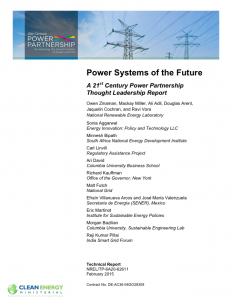Full Title: Power Systems of the Future: A 21st Century Power Partnership Thought Leadership Report
Author(s): Owen Zinaman, Mackay Miller, Ali Adil, Douglas Arent, Jaquelin Cochran, Ravi Vora, Sonia Aggarwal, Minnesh Bipath, Carl Linvill, Ari David,
Publisher(s): 21st Century Power Partnership
Publication Date: February 1, 2015
Full Text: Download Resource
Description (excerpt):
This report summarizes key forces driving transformation in the power sector around the world, presents a framework for evaluating decisions regarding extent and pace of change, and defines pathways for transformation. Powerful trends in technology, policy environments, financing, and business models are driving change in power sectors globally. In light of these trends, the question is no longer whether power systems will be transformed, but rather how these transformations will occur. Three approaches to policy and technology decision-making can guide these transformations: adaptive, reconstructive, and evolutionary. Within these approaches, we explore the pathways that have emerged as viable models for power system transformation, listed below.
- Next-generation Performance-based Regulation Pathway: In this adaptive pathway, vertically-integrated utilities remain in a recognizable form, but evolve to prioritize delivery of value instead of minimizing costs.
- Clean Restructuring Pathway: In this reconstructive pathway, new power market restructuring efforts are initiated, incorporating lessons learned from the past 20 years, including design features to facilitate clean energy integration and system optimization. Hindsight is 20/20—this reconstructive pathway brings hindsight to bear on restructuring and reform.
- Unleashing the DSO Pathway: Distribution system operators (DSOs) are poised to innovate in order to drive clean generation deployment and power system flexibility. In this evolutionary pathway, regulatory and policy frameworks give clear signals to these DSOs, empowering them as the centerpiece for orchestrating distributed energy resources and low-voltage market functioning.
- Bottom-of-the-Pyramid (BOP) Coordination Pathways: Accelerating energy access has been a chronic challenge for decades. New technology configurations and business models are opening up opportunities for innovative approaches to energy access, especially when linked to broader social development goals. In this context, two pathways emerge:
Adaptive Bottom-up Coordinated Grid Expansion
Evolutionary Bundled Community Energy Planning strategies, leading to integrated, socially-customized energy access solutions.
